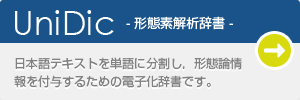Overview INTRODUCTION to the Corpus of Historical Japanese
The Corpus of Historical Japanese (CHJ) is being developed as a basic resource for research into the history of the Japanese language conducted in the digital age. As the "readings" (pronunciations), part-of-speech classifications, and morphological information are provided for all of the texts, the corpus not only can serve in place of the traditional concordances but can also be used for more advanced searches and statistical analyses.
It is our goal in the future to make the CHJ into a diachronic corpus that covers the whole historical range of the Japanese language, including texts in Old Japanese (the oldest attested form of the Japanese language), but at present we have published the following series as one part of the projected whole. For access to the contents currently in publication, please see the pages under the links below. Users will need to access the contents through the online search engine Chunagon. Completion of a Users Licensing Agreement (separate from that for the online publication of the Balanced Corpus of Contemporary Written Japanese) is required.
Corpus of Historical Japanese
- Nara Period Series I: Man'yōshū / II: Senmyō / III: Norito
- Heian Period Series I: Kana literature / II: Kunten materials
- Kamakura Period Series I: Folktales and Essays / II: Diaries and Travel Literature / III: Military Chronicles
- Muromachi Period Series I: Kyōgen / II: Christian Materials (Kirishitan Shiryō)
- Edo Period Series I: Share-bon / II: Ninjō-bon / III: Chikamatsu-joruri / IV: Essays and Travel Literature / V: Commentaries / VI: Kamigata Eiri Kyogen-bon
- Meiji Era / Taishō Era Series I: Magazines / II: Textbooks / III: Early Meiji Spoken Language Materials / IV: Modern Novels / V: Newspapers / VI: Rakugo 78 rpm Discs
The construction of the Historical Corpus of Japanese is being conducted in tandem with the following projects:
- NINJAL collaborative project "Design for a Diachronic Corpus" (Project leaders: Yasuhiro Kondō and Makirō Tanaka, 2009-2016)
- NINJAL collaborative project "Diachronic Corpus Construction and Prospects in Research on the History of the Japanese Language" (Project leader: Ogiso Toshinobu, 2016-2022)
- NINJAL collaborative project "Extending the Diachronic Corpus through an Open Co-construction Environment" (Project leader: Ogiso Toshinobu, 2022-2028)
- JSPS KAKENHI Grant Number JP15H01883 (Principal investigator: Ogiso Toshinobu, 2015-2019)
Note for users
Presentations of research results using the Corpus of Historical Japanese must include a citation taking the general form of the example below (with appropriate modifications depending on the version and the date of access):
* As long as one of either the version or the date of access is clearly cited, the other can be omitted, as below:
- National Institute for Japanese Language and Linguistics (2025) "Corpus of Historical Japanese" https://clrd.ninjal.ac.jp/chj/ (accessed March 31, 2025)
- National Institute for Japanese Language and Linguistics (2025) "Corpus of Historical Japanese" (Version 2025.11) https://clrd.ninjal.ac.jp/chj/
In addition, if only a part of the Historical Corpus of Japanese is used, such as the Heian Period Series, please follow the citation instructions provided on the webpages for each of the historical periods that were used.
Users will need to access the Corpus of Historical Japanese through the online search engine Chunagon. Completion of a Users Licensing Agreement is required.
Please refer to the following: The Corpus of Historical Japanese: How to apply
We strongly suggest that the user, when citing examples from the CHJ in a monograph, etc., include the location information, which is made up of the sample ID and the start location (sample ID, start location), as in the following example: (20-源氏1010_00005,28900).
With this information as elements of a search expression, users of the CHJ can find the example in question through Chūnagon, thereby making it possible to refer to other information about that example.
Furthermore, we suggest that users embed a permalink when citing an example from the online contents. Permalinks contain location information, allowing users to refer to the example in question in Chūnagon by the link with just one click on the URL
(example: 20-源氏1010_00005,28900).
Note that the permalink for a given search result can be displayed by checking the “permalink” box in the”列の表示 (retsu no hyōji ‘column display’)” section of the Chūnagon search page.
Development staff
This is a list (in Japanese syllabary order) of the names of the people involved in the construction of the Corpus of Historical Japanese.
- Atsumi, Maki; Adachi, Airu; Arai, Mio; Arai, Akihiro; Ikegami, Nao; Ikeda, Yukie; Ichimura, Tarō;
- Iwasaki, Rurie; Ueno, Sae; Umeda, Asuka; Ebina, Midori; Ōkubo, Ayumi; Ōsaka, Tomofumi;
- Ōshima, Hideyuki; Ōwada, Kennichi; Oka, Teruaki; Okada, Junko; Okabe, Yoshiyuki; Okamoto, Yūko;
- Ogawa, Shino; Ogiso, Toshinobu; Ogura, Hideki; Kasama, Yumi; Katayama, Kurumi; Katō, Fumiko;
- Kaneko, Ai; Kamiwada, Yūko; Kawaguchi, Atsuko; Kawashima, Takuma; Kawase, Akihiro;
- Kanno, Michimasa; Kikuchi, Sonomi; Kikawa, Azusa; Kitazaki, Yūho; Kubo, Masako; WU Ning Chen;
- Koike, Toshiki; Kōno, Tomoaki; Konishi, Hikari; Kobayashi, Masayuki; Kondō, Asuko; Kondō, Yasuhiro;
- Satō, Yū; Shigemura, Kotone; Shimoyama, Kanako; Shirai, Ryōsuke; Suzuki, Takao; Suzuki, Nao;
- Sunaga, Tetsuya; Zeniya Masato; Sogō, Noriko; Takada, Tomokazu; Takahashi, Yūta; Tagawa, Kaori;
- Takita, Yūko; Taguchi, Kumiko; Tanaka, Makirō; Tanaka, Minami; Tsuchiya, Aoi; Den, Yasuharu;
- Tokiwa, Tomoko; Tonomura, Ruri; Nakano, Atsuko; Nakano, Maki; Nakamura, Takenori; Nakamura, Ren;
- Nagumo, Chikako; Nishio, Maiko; Nishibe, Michiru; Noda, Takahiro; Noritake, Kozue; Hattori, Noriko;
- Hatono, Keisuke; Bando, Ryō; Hwang, Sooji; Fukuyama, Masami; Fujiike, Yumi; Fujimoto, Akari;
- Furukawa Yuko; Hoshikawa, Mutsumi; Hori, Asami; Horikawa, Chiaki; Matsuzaki, Yasuko; Mabuchi, Yoko;
- Miura, Satsuki; Miyamoto, Yūko; Murakami, Ken; Murayama, Miwako; Yamada, Saki; Yamada, Rina;
- Jaroash, Shimada, Mutsumi; Wakasa, Aya; Watanabe, Ayumi; Watanabe, Yuki


